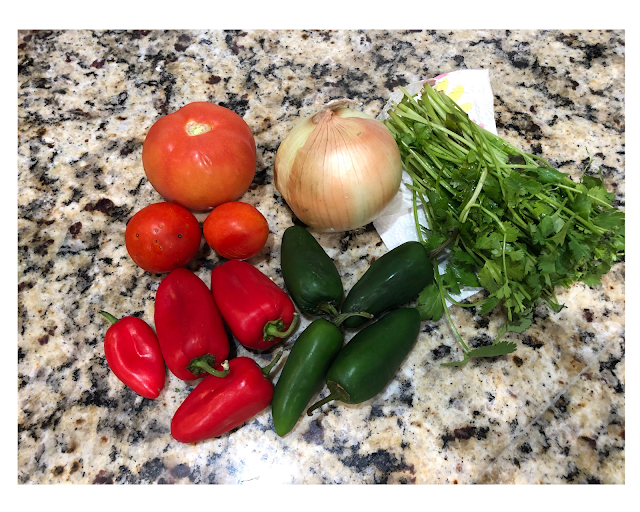Home-canned Garden Salsa
The recipe I'm sharing today is just your basic garden salsa, born out of the surplus of my container garden this year. No, I didn't get very many tomatoes (I've heard there's an art to that which I've yet to figure out), but I did get an abundance of jalapeño peppers, and since that's an ingredient I usually have to buy especially for salsa (I don't use them for very many things), it seemed like this was a good time to can some salsa.
A few words of warning here: The recipe I am using is from my canning Bible, the Ball Complete Guide to Home Preserving (I cannot recommend this book enough!), and in the marginal tip section, it states: "Always follow a tested home canning recipe for salsa. Do not add extra ingredients to the salsa prior to processing, as this can affect the acidity of the salsa, which is a critical factor in the safety of a home-canned product. You can always add ingredients before serving the salsa if you wish. Do not use salsa mixes unless they are specifically designed for home canning."
In other words, this is not one of those recipes you can tweak to suit your own tastes; if you want your salsa to be tasty and safe to eat, please follow the recipe exactly. That being said, this book has 14 different recipes for salsa, so if you want to try other recipes for home-canned salsa, feel free to check the book out. You can find it here or here for under $40, and you never know, another salsa recipe might show up on my blog in the near future! 😉
To make this canning recipe, you need your basic canning equipment--a large pot, canning jars with 2-part screw-on lids, a canning funnel and a magnetic grabber.
You also need 5-6 large tomatoes, 1 large onion, 1 large bell pepper (I used red and yellow this time, though green is traditional), 8 jalapeño peppers, 3 cloves garlic, a can of tomato paste, white vinegar, fresh cilantro, and ground cumin. The spiciness of the salsa is entirely up to you, depending on how much of the jalapeño's seeds and veins you put in the salsa. My family likes it very mild, so I think I put 3-4 seeds in the entire batch.
Start by blanching the tomatoes so they're easy to peel, then coring and chopping them into medium-small chunks. Deseed and coarsely chop the peppers and onions; if you're using fresh garlic (I use pre-minced), peel and chop that. Finely chop the cilantro, then add everything into the pot to begin cooking.
(A word on chopping jalapeños: if this is your first time doing it, please make sure to wear a pair of rubber gloves! Trim off the stem end and cut the pepper in half; using a spoon, scrape out the desired amount of seeds and veins from the pepper, then chop up the rest. Wash your hands when you're done with all the peppers and whatever you do--don't touch your eyes!)
Bring the whole batch to a boil over medium-high hear, stirring constantly, then reduce the heat and boil gently, stirring frequently, until it's as thick as you want it, about 30 minutes. It will be quite soupy and resemble the consistency of store-bought salsa at this point.
Meanwhile wash your canning jars, and put the lids in a pot of boiling water on the stove. This will soften the wax around the rim so it creates an airtight seal on the finished jar. With the help of the canning funnel, ladle the salsa into a canning jar, leaving about 1/2" of headspace, then use the magnetic grabber to fish the lid out of the boiling water and center it on the filled jar. Screw the band to fingertip-tight and set the jar aside. Continue until all the jars are filled or the salsa is gone.
Once all the jars are filled, they need to be processed to ensure an airtight seal. This can be done one of two ways: either you can place them in a large pot of boiling water for 20 min. or you can simply turn them upside down immediately after filling them and allow the hot contents to melt the wax to the rim.
The first way is the traditional, recommended way of processing home-canned goods, the second is the way I prefer to do it for reasons I will not go into here. If you want to read more about both methods of processing canned food, check out my blog on Homemade Strawberry Jam; it goes into more detail on all the steps in the canning process. Whichever way you process your salsa, you'll know you have an airtight seal when you press on the lid, and it doesn't pop back up.
Like all home-canned goods, homemade salsa can be stored on the shelf for ideally 1 year, but up to 3-4 years unopened; once it is opened, store in the refrigerator and be careful of cross-contamination.
Simple, right? And it only takes about an hour and a half--perfect for a weekend project, but with very tasty dividends! 😋








Comments
Post a Comment